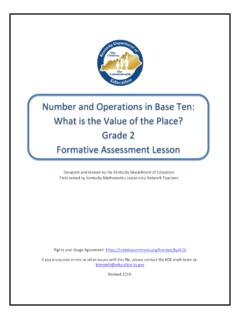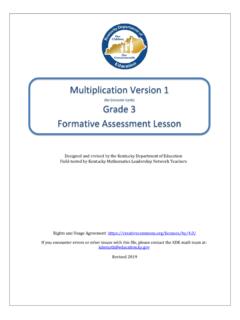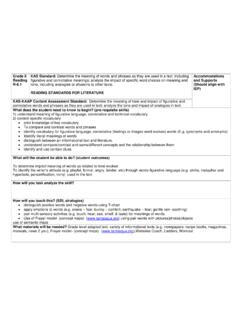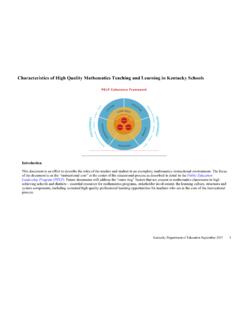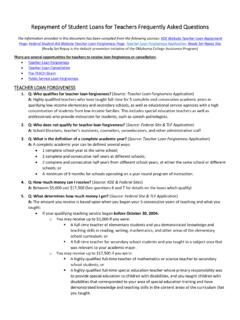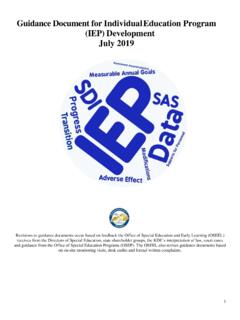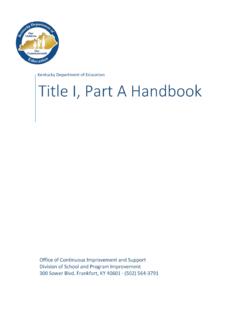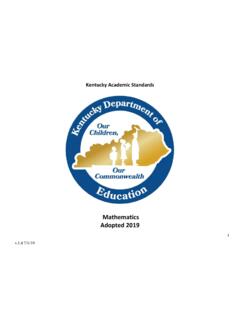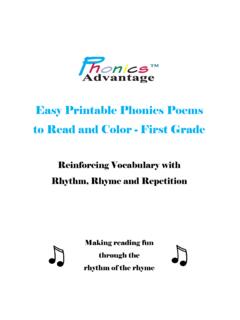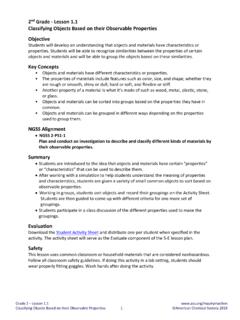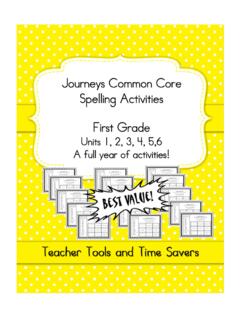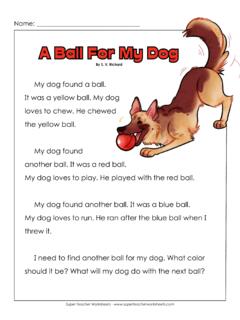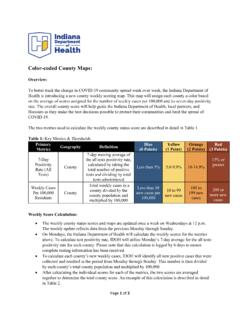Transcription of Grade: 1 Formative Assessment Lesson - Kentucky
1 Designed and revised by the Kentucky Department of Education Field-tested by Kentucky Mathematics Leadership Network Teachers Rights and Usage Agreement: If you encounter errors or other issues with this file, please contact the KDE math team at: (Revised 2019) Domain: Operations and Algebraic Thinking Title: Greater Than, Less Than, Equal To in Range up to 10 grade : 1 Formative Assessment Lesson 2 Greater Than, Less Than, Equal To in Range up to 10 grade 1 Mathematical goals This Lesson is intended to help you assess how well students are able to: Recognizing equivalent expressions (number sentence).
2 Using strategies to determine related expressions (number sentence). Recognize and use the symbols =, <, >, -, + Kentucky Academic Standards: This Lesson involves mathematical content and practice standards from within kindergarten and grade 1, with emphasis on: Kindergarten Identify whether the number of objects in one group is greater than, less than, or equal to the number of objects in another group. , , Compare two numbers between 1 and 10 presented as written numerals. grade 1 Solve word problems that call for addition of three whole numbers whose sum is less than or equal to 20, by using objects, drawings and equations with a symbol for one unknown number to represent the problem.
3 MP. 1, , Apply properties of operations as strategies to add and subtract. MP. 2, Add and subtract within 20. a. Fluently add and subtract within 10. b. Add and subtract within 20, demonstrating fluency for addition and subtraction within 10. Use strategies such as counting on; making 10; decomposing a number leading to a 10; using the relationship between addition and subtraction; creating equivalent but easier or known sums. , , Understand the meaning of the equal sign and determine if equations involving addition and subtraction are true or false. MP. 2, Determine the unknown whole number in an addition or subtraction equation relating three whole numbers.
4 MP. 1, Compare two two-digit numbers based on meanings of the tens and ones digits, recording the results of comparisons with the symbols >, =, and <. This Lesson involves a range of Standards for Mathematical Practice (MP), with emphasis on: MP1. Make sense of problems and persevere in solving them. MP2. Reason abstractly and quantitatively MP3. Construct viable arguments and critique the reasoning of others MP4. Model with mathematics. MP7. Look for and make use of structure MP8. Look for and express regularity in repeated reasoning. This Formative Assessment Lesson is designed to be part of an instructional unit.
5 This task should be implemented approximately two-thirds of the way through the instructional unit. The results of this task should be used to inform the instruction that will take place for the remainder of your unit. 3 Introduction This Lesson is structured in the following way: Before the Lesson , students work individually on an Assessment task that is designed to reveal their current understandings and difficulties. You then review/analyze their responses and create questions for students to consider/answer in order to improve their solutions. After a whole class introduction, students work in partners on a card matching activity.
6 Students work with a partner in a collaborative discussion tasks. Throughout their work, students justify and explain their decisions to their peers. Toward the end of the Lesson there is a whole class discussion. Students return to their original Assessment tasks or a similar task and try to improve their own responses. Materials Required Each individual student will need: Two copies of the Assessment task Greater Than, Less Than, or Equal? per student. Each student will need a red, a yellow, and a blue crayon Each pair of students will need the following resources: (It is recommended to put sets on different colors of cardstock or construction paper and laminate for durability.)
7 Card Set A (already cut out and laminated in an envelope) Chart A Card Set B (already cut out and laminated and hand out to groups as they finish Card Set A) Chart B Card Set C (already cut out and laminated and hand out to groups as they finish Card Set B) Chart C Blank Template Chart D (hand out to partners as they finish Card Set C) (Students will not need Cards for Chart D. They will write their expressions (number sentences) on the chart.) Card Set E (already cut out and laminated in an envelope) **ONLY USE WITH GROUPS THAT STRUGGLED WITH THE PRE- Assessment OR GROUPS THAT STRUGGLED WITH CARD SET A.
8 CARD SET E IS FOR CHECKING UNDERSTANDING OF VOCABULARY FOR GREATER, LESS, AND EQUAL Teacher materials needed for this FAL: Markers Anecdotal Notes on FAL A set of Card Set A Chart A written on large chart paper for whole group discussion Time Needed: Approximately 15 minutes for the individual pre- Assessment task (at least a day or two before Lesson ), Two 40 - minute lessons (30 minutes for partner task and 10 minutes for whole class discussion), 15 minutes for the individual post- Assessment task. Times given are only approximate. Exact timings will depend on the needs of the class.
9 All students need not complete all sets of card activities. Before the Lesson : Assessment Task: Greater Than, Less Than, or Equal? (15 minutes) Have students do the initial task, Greater Than, Less Than, or Equal? Individually in class a day or two before the Formative Assessment Lesson . REMEMBER: You will give this same Assessment again as a post- Assessment .) This will give you an opportunity to assess the work, and to find out the kinds of misconceptions students have with it. 4 You will be able to target your help more effectively in the follow-up Lesson .
10 Depending on your class you can have them do it all at once or in small teacher-led groups (they should still work individually.) Framing the pre- Assessment : (10-15 minutes) Give each student a copy of the Assessment task Greater Than, Less Than, or Equal? and read the directions. You may need to model one on the board. Teacher says: Look at the card at the top of the page. If the expression (number sentence) is greater than (>) the shaded box, color it red. If the expression (number sentence) is less than (<) the shaded box, color it blue. If the expression (number sentence) is equal to (=) the shaded box, color it yellow.
